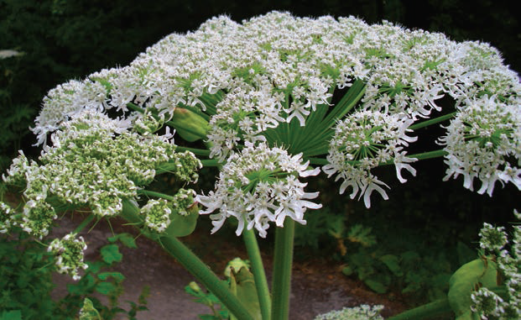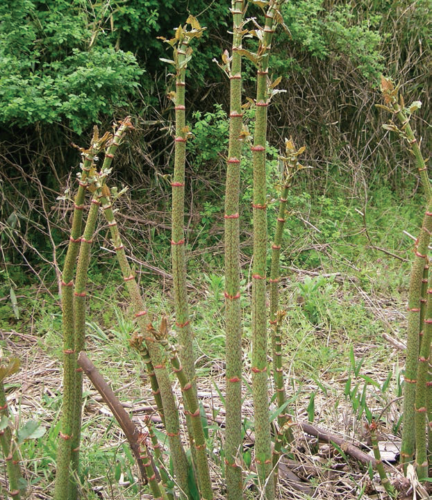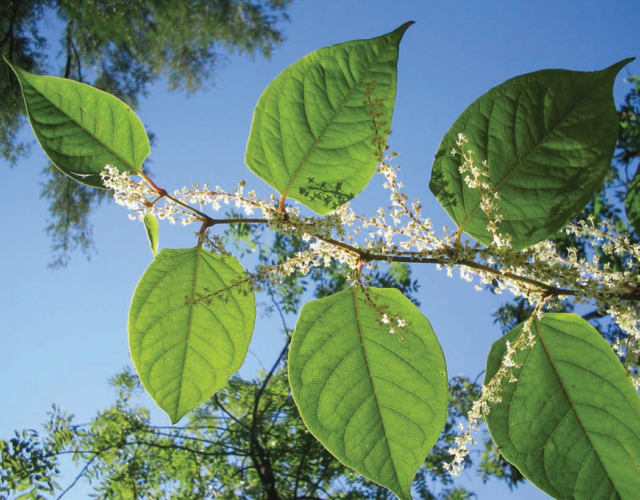Perspectives on weed control in the Irish landscape
| To the casual observer the verdant Irish landscape is something of great beauty and awe. Greenery spills from every niche and crevice while hedgerows heave, encroaching on paths and roadways across the country. To the informed eye, this lush blanket is something of both wonder and concern. The sheer range of species and physical mass is inspiring to say the least. But the concern is justified. It may be silent, but there is a war taking place. A war on diversity and design where invasive species are outcompeting natives and designed schemes. Bindweed, hogweed, knotweed and giant rhubarb are just four of the more conspicuous combatants firmly establishing their dominance.
In addition to reducing plant diversity through competition, the problems presented by these invasive colonisers include negative impacts on pollinators, financial losses through damage to schemes and the need for intervention, planting becoming unsightly, the potential for increased chemical use in the landscape, and yield reduction in the case of production. In the UK, you can no longer get a mortgage on a property with knotweed. I’m sure we won’t be far behind. As custodians of the Irish landscape, we are most certainly on the back foot in this ongoing battle. A number of factors continue to support our opponents and undermine the efforts of individuals. Ireland has only just recognised ‘landscape’ this year with the launch of the National Landscape Strategy. We have no coordinated approach to tackling invasive species. The landscape profession is woefully underrepresented in county councils, and in the majority of cases, simply not represented at all. Our existing landscape design, procurement and delivery systems are essentially worthless in terms of weed management. Budgets for the management of public landscapes (via parks departments) continue to be eroded and centre on short term strategies and interventions. The recent French ban on glysophate herbicides and EU changes to chemical use have thrown the issue into the spotlight. So, we’ve got a pitched battle on our hands, we’re under-funded, under-valued, under pressure from Europe and fighting opponents who’ve seen off better organised, informed and resourced adversaries. We are losing the battle and the actions we take in the next few years will have repercussions for decades to come. To get an idea of what actions we should be taking, we asked a number of experts to pinpoint the problems and most appropriate solutions for Ireland. |
A LAW UNTO THEMSELVES
Kieran Cummins, an environmental law specialist, shares his thoughts on action, inaction and sector responsibility


While the 2011 regulations [SI.477] are a welcome addition to the Irish legal framework, four years on, there is still little change. It’s taking much longer than envisaged to implement section 50 and we are still waiting for the final publication and implementation of the schedule specifying the prescribed species. In the meantime though, the National Biodiversity Centre in Waterford has done extensive vetting work on various specified species.
The industry for its part must be very careful about new plant introductions. While many plants might not actually be on the list of prescribed plants, some new introductions have the capacity to wreck havoc throughout the countryside and indeed in people’s gardens. When a consumer plants their garden with plants purchased from a garden centre, they should expect them to behave normally and not become invasive. In other words, the horticultural industry has a duty of care to the consumer. For my part, I once planted some Euphorbia cypressias in my herbaceous border only to discover this plant very quickly took over. I was obliged to remove them less than a year later, and two years on am still fighting remnants of this hideous plant with glyphosate, which had spread to and infested other plantings.
While it is true to say that numerous financial institutions in the UK refuse to issue mortgages in cases where Japanese knotweed has been identified, it is worth noting that this is to protect their interest (owing to the substantial costs involved in eradicating the offending plants) rather than for any environmental concern. The costs of eradication can be very hefty, as was seen recently where about €100,000 was required to deal with an infestation of Japanese knotweed on the site for the Regional Hospital in Kenmare, County Kerry.
Enforcement of environmental and planning legislation continues to be poor and lethargic. The concept of ‘selfpolicing’ of planning legislation is still pursued. For the less initiated, ‘ self-policing’ simply means that developers implement the conditions of a planning consent and periodically submit various specified documents to the planning authority, which has to some extent become a box-ticking exercise. Experience has shown that enforcement of such planning consents in some counties is very poor. At the kernel of the ‘self-policing’ policy is the lack of resources for enforcement generally.
The lack of trained horticultural staff in most local authorities (save for the larger ones with parks departments) remains problematic. In addition to the normal assessment process in planning applications, if sites were also vetted by horticulturalists for the existence of invasive species and appropriate screening proposals, this would indeed be a progressive step forward. Recently I was part of a delegation to explore a significant site on which a large development had been declined by (for reasons other than horticultural). While being driven through the site (a woodland area), I was astounded to see significant swaths of Japanese knotweed. On pointing this out to the developer/manager, he hadn’t a clue what I was alluding to and assured me that he was sure their gardener had the matter under control!
Horticulture is not on its own when it comes to a lack of enforcement. There have been numerous criminal law enactments over the last decade. It is worth noting that in some cases there have been few if any prosecutions brought under the new legislation. Therefore, legislation on its own will not adequately address the serious problem of invasive species.
Some people rightly inquire whether noxious weeds are still on the statute book. The answer is in the affirmative. The problem is, ragwort is everywhere and often in large numbers on the centre medians of motorways (the responsibility of the statutory authorities). In such circumstances, people are entitled to and should be encouraged to report it, in writing, to the relevant Garda station who is the statutory enforcement authority for the noxious weeds act. It must then, of course, be pursued by the gardai.
“€100,000 was required to deal with an infestation of Japanese knotweed on a site for the Regional Hospital in Kenmare, County Kerry”
The editor has aptly alluded to changes to EU herbicide laws and specifically to a prohibition on the use of glyphosate in some countries. If this product were prescribed in its totality, even greater challenges would be presented to the eradication of invasive species than currently exist. It is therefore incumbent on all stakeholders to take immediate action to curtail the spread of these virulent plant species while such chemicals are still available.
Given the length of time it has taken to augment the earlier Noxious Weeds legislation, by prescribing the species currently threatening the countryside and generally known as invasive species, it is likely to take significant time for the latest legislation to be updated with the addition of new species as they occur. The last addition to the Noxious Weeds Act of 1936 was under SI.194 of 1973, which proscribed Wild Oats. This is some 42 years ago.
Therefore it is incumbent on the sector to be more vigilant and careful with the introduction of new species to the marketplace. ✽
LOCAL AUTHORITIES AND INVASIVE SPECIES
Hans Visser, biodiversity officer with Fingal County Council, outlines the roles of local authorities in addressing the issues and highlights several areas for action


1. Raising awareness of invasive species
2. Planning permissions controls and local authority projects
3. Control and eradication measures

Raising awareness
Various local authorities have developed awareness campaigns on invasive species to notify the general public and interest groups of the presence of invasive species. These campaigns often request the public to send in their records of locations with invasive species to the local authority or the National Biological Record Centre, and they give an overview of what control measures are available. The campaigns help to make people aware of the problems associated with invasive species and help to establish the full extent and spread of the invasive species in a county.
Planning permissions & local authority projects
Preventing the spread of invasives is a vital first step to make sure the problem doesn’t get any worse. When development is planned on a site with invasive species the chances of spreading the problem due to earthworks are significant. The planning process allows for management plans to be drawn up, implemented and monitored as part of the planning permissions. These management plans give an overview of what works are to be undertaken, how and when they are to be done comma added and who is going to do them. This does require the invasive species to be identified before development starts, but not all planners and developers are skilled at identifying them.
Furthermore, if the landscape around the development site is heavily infested, any treatment of the invasive species within the development site is unlikely to be successful in the long term.
Control and eradication
Actively controlling invasive species is essential if we want to get on top of the spread. Various local authorities have started control programmes, but budget cuts often mean that multi-annual control cannot be continued. Dealing with invasive species on a river catchment level also requires cooperation between many landowners and sometimes different local authorities. If some landowners are not interested in participating or refuse access to their lands in the upper catchments, then it is almost pointless doing a lot of work in the lower part of the catchment. Furthermore, different local authorities may have different priorities in dealing with invasive species and may not necessarily want to deal with a particular catchment at the same time.
There is much room for improvement in dealing with invasive species in Ireland. First of all, a clear national strategy or coordinated approach for dealing with invasive species in Ireland needs to be developed. A national publicity campaign to make people aware of the problems posed by certain invasive species is a second step. Thirdly, funding to carry out invasive species survey work and control work are currently very limited. A dedicated invasive species fund of several million euro is required annually for at least a decade to control some of the key invasive species. Such a fund could be administered by Invasive species Ireland or the Heritage Council. A long term commitment to provide a dedicated fund is essential because most invasive species require a multi-annual program to bring the species under control.
Finally, the people need to be identified who will deliver this programme cascading down from central government to the local landowners. County councils can have a central coordinating role at the county level. Biodiversity officers, heritage officers and parks department staff, for example, can act as the coordinating person in each county. If the local authority does not have staff available, it might be possible for a landscape consultant/contractor to be appointed to provide the coordinating role for at least a five year period. Local community support would be required, however, particularly in the bigger counties, to show the individual sites to contractors and monitor the effectiveness of the treatment. Local tidy towns groups, inland fisheries representatives, farmers’ representatives, community councils, landscape contractors etc could all help to deal with invasive species at the individual site level and report back to the central coordinating person in the county council.
Controlling invasive species will require a lot of effort, but at the same time, it might provide employment opportunities. And not dealing with the issue is going to cost a lot more in the future. ✽
THE INVASIVE PLANT ‘BUCK’ STOPS – WHERE?
Terry O’Regan, landscape architect and industry activist, shares a unique perspective on the issues and way forward


The very real and horrific scenario called up by the recent German Wings air disaster must give every airline passenger an uneasy sensation as they fasten their seat belts and the plane trundles down the runway for takeoff. Can you trust the pilot?
But that was a scenario where there was someone in control, even though he was plotting a terrible destructive flight path. Would you feel any better if there were no one at all on the flight deck, and the airline owners were hoping that by some miracle of autopilot technology the plane would fly itself to the destination airport and land successfully? Well, in the Ireland of 2015 you are being well prepared for such a scenario as the country is largely being governed via auto-pilot thinking and technology, held together by the long-established ‘wing and a prayer’ philosophy.
We have arrived at the stage where the geniuses that occupy government buildings think that if they draft and adopt a piece of legislation, or a regulation or even a strategy, then by some miracle of ‘autopilot technology’ the intent of the legislation, regulation or strategy will be conveniently and neatly delivered without any TD or official having to work up as much as a polite sweat.
There are a few genuine horticulturalists reading this piece and if they are of my generation they will know that the invasive aliens that are exciting Dublin 4 at the moment did not land last year in some remote Wild Atlantic Way inlet along with a few bales of invasive alien poppy seed pod extract.
For a very long time, the Irish hills have been alive with the sound of the march of the alien invaders. Driving through the Irish landscape you must ask if the message being sent by the fading sound of the bolting horses should be heeded. At what stage does an invader become as native as the natives?
But news from outside the confines of Dublin 2 takes time to reach the corridors of Leinster House. And it will take another few centuries – if we are lucky – for the hothouse flowers in Leinster House to gather the courage to engage this triffid enemy.
Back in the 1950s when I was taken by my parents to view the wonder of the wild rhododendron in full bloom on the slopes of the Knockmealdown Mountains there were structures in place that might have co-ordinated a campaign to tackle the invasive alien attack. You had horticultural advisers in each local authority, you had a well-resourced research agency in Kinsealy and elsewhere. The one thing you had very little of was herbicide. The only one I knew of was sodium chlorate and I was more interested then in the explosive mix it created when combined with sugars than I was in its weed-killing capacity. (Sodium chlorate was banned shortly afterward).


Invasive alien plants and other unwelcome invasive organisms do indeed require a coordinated managed response. It is difficult to see how the current fragmented, inadequately resourced, effectively leaderless reaction is going to make any useful headway. In the meantime, the landscape industry must continue to do its best to advise and assist its clients. Bearing in mind that the new legislation has introduced strict limitations and controls with regard to managing sites where such plants occur, landscape consultants and contractors will need to become expert in dealing with same and there would appear to be an urgent need for information sessions and workshops. I personally believe that in the case of Japanese knotweed at least it should be possible to come up with more flexible approaches than the current two options of leaving a site idle for years while a herbicide programme is carried out, or bringing in the heavy gang at great expense to beat the shy** out of the invaders and bury what’s left.
It strikes me that there is a compromise between these two positions that would allow development to proceed accompanied by professional grounds maintenance programmes.
There are many cans of worms on this particular menu and the fact that glyphosate may well become an unwelcome ingredient might focus minds on more sustainable longterm responses to the invasive alien plant issue, but I am not holding my breath. In this case, it strikes me that as a matter of urgency, glyphosate needs to become a controlled material only available to trained and licensed users. In the meantime wave back at the worms! ✽








